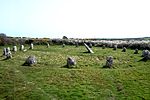Sancreed Beacon
Buildings and structures in CornwallHistory of CornwallIron Age sites in CornwallMining in CornwallPenwith ... and 1 more
Prehistoric sites in Cornwall

Sancreed Beacon is a Bronze Age archaeological site near the village of Sancreed in the Penwith peninsula of Cornwall maintained by the Cornwall Heritage Trust. On top of the hill are several stone cists and Bronze Age archaeological remains comprising burial mounds and the remains of a Bronze Age hut on the Western slope. This site can be taken in the context of a rich variety of archaeological evidence in the vicinity from the Iron Age, Bronze Age and dating as far back as Neolithic times including Carn Euny Iron Age village 1 mile to the southwest, Caer Bran Hill Fort half a mile southwest, Sancreed Holy Well to the southeast, and Bartinney Castle to the west about 1 mile.
Excerpt from the Wikipedia article Sancreed Beacon (License: CC BY-SA 3.0, Authors, Images).Sancreed Beacon
Geographical coordinates (GPS) Address Nearby Places Show on map
Geographical coordinates (GPS)
| Latitude | Longitude |
|---|---|
| N 50.109144 ° | E -5.618209 ° |
Address
TR20 8QZ , Sancreed
England, United Kingdom
Open on Google Maps









